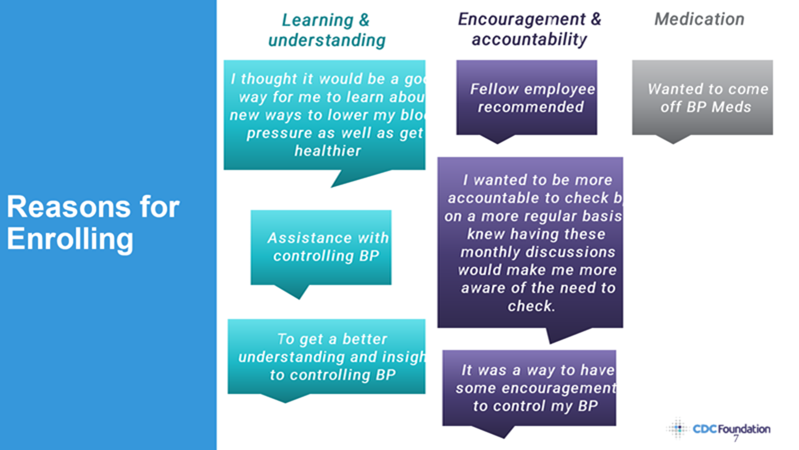Carpeting manufacturer Engineered Floors in Dalton, Ga., wanted to control its escalating medical costs without raising health insurance premiums. Through BP First, participants lowered their blood pressure (BP) by an average of 11 percentage points and their body mass index by an average of 0.7 percentage points.
The six-month pilot program was part of a larger wellness initiative, Working for Life, that encourages regular health screenings and simple lifestyle changes—such as adapting healthy eating habits, exercising more and learning to monitor blood pressure at home—to help prevent or manage chronic disease.
"One thing we learned is that our employees would not use their health care [benefits] if they felt it cost too much or it wasn't convenient for them to get to the doctor," said Kaitlin Wade, the company's wellness coordinator.
Wade, who joined the company in 2017, developed a partnership with the CDC Foundation to create BP First. Employees diagnosed with hypertension or who were on blood pressure medication could opt into the program. Among the 506 employees, 27 of the 216 employees diagnosed with hypertension participated in the pilot. Having health insurance through the company was not a prerequisite for participation.
Participants were given time during their workday to meet with pharmacists at the worksite to discuss their medications, learn to monitor and document their blood pressure, and learn about lifestyle changes that could decrease their hypertension.
"A lot of people didn't realize that sodium intake affects blood pressure," Wade said. "Especially with our population working 12-hour shifts, they were eating a lot of canned soups and frozen meals that have excess salt.
"A pharmacist was able to take the holistic approach and say … 'Let me take your blood pressure. Let me talk about some of the areas you can improve outside of just taking medication,' " she noted.
Participants identified goals they wanted to achieve through the program, such as being active, eating more healthfully, and monitoring their blood pressure and blood sugar.
"I still take blood pressure medicine, but my blood pressure is doing good and [I take] a pill nightly for the blood sugar, which at the time [I began the program] was 8.7. It is now down to 6.0," she said. She asked not to be identified by name for privacy reasons.
The program helped her make better eating choices, she said, and encouraged her to start a walking program. She's been able to maintain the regimen as she continues to work on achieving her health goals.
"I take each day at a time trying to make better lifestyle choices," she said. "I know that my problem is something that I will need to always work on."
Lessons Learned
The in-person approach had to quickly switch to a telehealth model when the COVID-19 pandemic hit. Today, all employees, including those who participated in the pilot, primarily access Working for Life programs on-site, but some programs and services can be provided in other formats.
Since launching the pilot, the company learned it needed to expand its focus to a variety of chronic diseases, Wade said.
"We were able to find gaps in services and programs we are currently offering in relation with hypertension and overall cardiovascular health, to ensure we continue to strive toward providing the most beneficial services and programs to our employees," she said.
Instead of continuing a program focusing solely on blood pressure, "we are going to take what we learned through the program and continue to evolve Working for Life and provide affordable and convenient preventive services to our population," Wade said.
"If you are going to go into business where you need people to help accomplish your goals, don't you want them in the best physical and mental state of mind?" Fordham asked. Early detection and prevention were key to improving employee health and ultimately controlling health care costs, he noted.
Wade said regular discussions about overall health helped motivate employees to set health-related goals "and make positive changes that impacted their lives well beyond the workplace."

"Anything that we can offer employees that will help them engage in their personal health on their terms and fit their lifestyle, we try to do it," Fordham said. "We believe if we can catch [a health issue] early, or if we can prevent something, everyone benefits."
BP First offered health care at no cost and at the worksite. Health care providers collaborated with the BP First team, the company offered preventive screenings and visits with onsite nursing staff, and participants could work with the wellness coordinator to identify healthy habits.
3. Get leadership on board.
"Our leaders are some of our highest-use customers," Fordham said, noting that they take advantage of Engineered Floors' programs as much as its hourly employees do. "They then become the champions by just showing up." When they get in line to speak to the pharmacist, for example, it sends a big message to all employees, he explained.
"You start a conversation. You get to know the employee," she said. "It all starts with building relationships."
An organization run by AI is not a futuristic concept. Such technology is already a part of many workplaces and will continue to shape the labor market and HR. Here's how employers and employees can successfully manage generative AI and other AI-powered systems.




